| |
Camp Wollbach re-named to Camp Phillip L. Lee, the Eaglehorse honors
a fallen hero
-
58, 193 hostile and non hostile US forces killed
in Vietnam conflict
-
3096 hostile and non hostile US forces killed
with Ohio listed as home of record
-
2357 hostile and non hostile US forces killed in
Vietnam during 1971
-
729 Blackhorse troopers hostile and non-hostile
killed in Vietnam
-
10 hostile and non hostile US forces killed in
Vietnam on 17 April, 1971. Sergeant Willis Norwood Andrews,
Specialist 5th Grade George James Orr and Specialist 4th Grade
Gray Lee Reynolds all of Troop F 2/11 ACR are killed in a sharp
fire fight in Binh Doung Province. First Lieutenant Phillip
Lewis Lee is severely wounded and evacuated.
-
7 US soldiers hostile and non hostile killed in
Vietnam / dead of wounds in US hospital system on 6 June 1971,
First Lieutenant Phillip Lewis Lee dies of wounds received in
Vietnam. He had been evacuated to a VA hospital in the United
States.
| |
|
|
|
|
| |
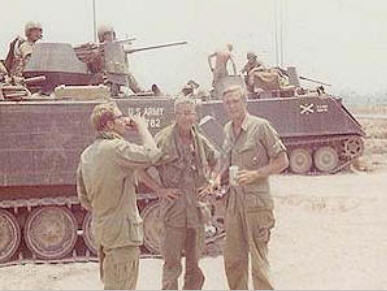
Lt Lee at left with platoon in 1971.
--Danny Jordan / Echon |
|
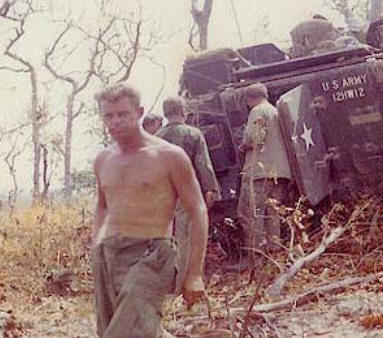
Lt Lee in the field.
--Danny Jordan / Echon |
|
| |
|
|
|
|
LTC (Ret) Lee Allen: At the time that Phillip Lee was
wounded, which as I recall was on April 17, 1971 LTC John L.
Ballantyne was the squadron commander of the 2nd Sqdn (Separate) and
I was the deputy commander and rear detachment commander. We were
what was left of the regiment after the others stood down and
returned home. We had an aviation company and a maintenance company
and numbered about 1,700 officers and men. We were OPCON to a
brigade of the 1st Cav Div (3rd, I think) and were operating north
and east of Chu Chi, northwest of Saigon. The primary mission at the
time was securing the operation of a Rome Plow company and general
security of the area.
The day Lee was wounded, E and F Troops, as I recall, were out on a
recon in force. They took some fire from a hedgerow and moved in. At
that time they took increased fire, from the sides as well as the
front, if I remember correctly. Several vehicles were hit with RPG's
and a number of them burned. The units were in the fire zone for
quite a time and it wasn't until Maj. Borden the S-3 and the CO got
to the scene and started coordinating the effort that things cleared
up. The entire action took several hours and ended with a dismounted
assault on the hedgerow which held the enemy positions. As I
remember we lost five KIA and about a dozen WIA in the action.
Lee took a bullet across the shoulder blades which cut his spinal
cord and paralyzed him. He was evacuated to Bien Hoa. I visited him
there a couple times. The squadron had an NCO assigned to the
hospital to see that all of our wounded got whatever they needed.
| |
|
|
|
|
| |

Lt Lee.
--Tony " Doc " Balas / Echon |
|
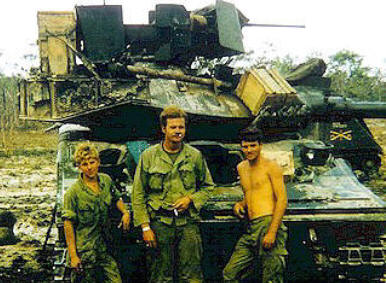
At left, Gary Lee " short round "
Reynolds, killed in the same engagement in which Lt lee was mortally
wounded. We have been unable to find images of Willis Andrews and
George Orr.
--Ken Vander Hoek / Echon |
|
| |
|
|
|
|
Wayne Watts: It was just after noon on April 17. It was
bright and hot. We were on a recon patrol. The order of march was
first platoon, second and third platoon. First platoon had already
made their right hand turn away from the hedge row on our left. For
some reason the entire column stopped. This left the second
platoon’s left side exposed to the hedge row area. We naturally
looked to the area where we thought the enemy might be. I was
looking through my binoculars and saw and NVA regular soldier
standing in the center of the hedge row motioning for us to come on
in. I called Lt. Lee and advised that we had NVA on the left. (To
this day, I can still see that NVA pith helmet and the star with the
round circle on it.) We immediately traversed to the left and got on
line for an assault. We were in a no-fire zone and Lt. Lee had to
call for permission to fire on the NVA. At this time the NVA had not
fired at us. we received permission to fire with small arms only
(7.62 or below). We began firing on the dug-in hedge row and bunker
position we received RPG, 51 Cal. and rocket fire.
At this point, I was looking at Lt. Lee when I saw him get hit. My
first impression was feathers flying from the back of his neck. I
later learned that it was a pillow that he was resting his back on
that was hit. The medic, Doc Tony Balas, rode on my track (F-25). I
told Doc, "the LT. has been hit. Hold on and I will get you over
there." Doc immediately jumped off my track and ran over a dug-in
bunker position to get to Lt. Lee's track. We immediately opened up
with all weapons to include the main gun on the Sheridan tanks and
50 cal. on the ACAV's...and anything else we could find.
We stopped and called the S-3 Air for artillery support. The reply
came back, " Negative " We are cavalry. Charge!
We assaulted the hedge row dug in bunker positions and over ran
them. As we backed out, one of the Sheridan tanks received a direct
hit and burst into flames. This is tank that Spec/4 Gary Reynolds
was the driver and could not get out of the drivers compartment. The
loader had already jumped off the tank because it was in flames. We
tried to get to the tank but could not due to intense heat and enemy
fire. I saw Gary once try to come out of the loaders hatch and saw
him when he was hit by enemy fire and fell back inside the tank.
| |
|
|
|
|
| |

Camp Wollbach re-named to Camp Lee 1976. This is a scan of a photo
copy that Erwin Ritter sent. It was originally in the 2 June 1976
Main Post Wurzburg newspaper with a brief article in German noting
the re-naming of Camp Wollbach to Camp Phillip L. Lee.
The article gave a very brief overview of the border surveillance
mission, the 2/11 ACR and the history behind the new name. It
mentioned that Lt Lee's mother attended the re - naming ceremony as
well as the Regimental Cdr, Col Ballantyne and the Camp OIC,
identified as LTC Lee Allan. All three people are visible with backs
to camera in the scan.
-- Ritter |
|
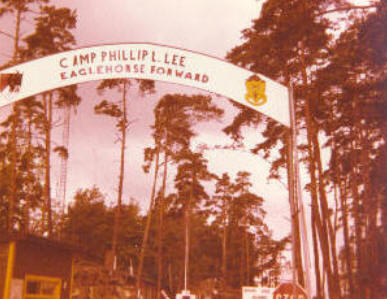
The Camp Lee sign as of 1980.
--Mitchell |
|
| |
|
|
|
|
We fought until dark. E Troop also arrived and assisted in the
assault. As night fell and we all pulled back, this is when we
brought in artillery, mortars and air strikes through out the night.
We had approximately two people left on each vehicle that had not
been wounded or dead.
Michael Craig: I served with Lt. Lee when he was killed. In
fact we were dusted off on the same helicopter.
Lee Allen: Lee took a bullet across the shoulder blades which
cut his spinal cord and paralyzed him. He was evacuated to Bien Hoa.
I visited him there a couple times. The squadron had an NCO assigned
to the hospital to see that all of our wounded got whatever they
needed.
It was clear from the beginning that Lee was very seriously wounded
and would probably never recover. When I talked with him I was
impressed with his courage and good nature in the face of a
terrifying future. He was soon evacuated to the States. I did not
know it at the time but was later told by his mother that the sort
of wound he had almost never was overcome and that the spinal cord
injury that high almost always resulted in lung failure and death in
a matter of weeks. I recall that she said he lasted about 5 or 6
weeks. He left behind a young wife and mother.
| |
|
|
|
|
| |
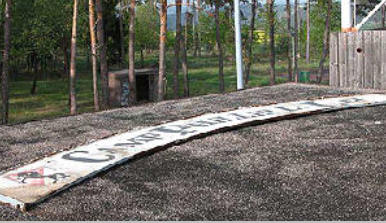
The Camp Lee sign as of May 2003 as
found on top of the two bay motor shop.
--Norbert Ruckel |
|
| |
|
|
|
|
Col (Ret) Clint Anker: The idea for renaming the camp came
from LTC Lee Allen, who was commanding 2/11 ACR at the time. He had
served with LT. Lee in Vietnam, if I remember correctly. Lt. Lee's
mother came out to the camp for the ceremony.
Lee Allen: When the idea of renaming Wollbach came up I
remembered Phillip Lee because his situation seemed to represent a
lot of what the Vietnam war came to be. He had faithfully answered
the call of duty, had served with dedication, was mortally wounded
and died. He left behind people he loved and who loved him. His
death was the ultimate sacrifice to duty, honor and country.
I am not absolutely sure who had the idea to rename the border camp.
I had been trying to remind the squadron of the service of the unit
only a few years before and the value of upholding that tradition.
However it came about, I think everyone who heard of it came to
support the idea. I recall that we sent a request through channels
to USAREUR. It returned in record time with positive endorsements
from all levels.
At this time I am unable to recall all the many efforts made by
squadron members to set up the program to rename the camp, but two
seemed particularly important. Maj. Lou Voelkel, XO, made it
possible to bring Philip Lee's mother over for the ceremony. During
our annual gunnery trip to Grafenwoehr he cornered the market on
flip-top beer to sell in our canteen.
Flip tops were popular and many came to our squadron
to partake. Lou made about $1,300 profit, as I recall, and all that
money was used to bring Mrs. Lee from the states and make her
welcome and comfortable while she was a guest of the squadron. It
was a little out of the ordinary to handle things this way but it
worked.
Major Frank Kolezar, S-3, was a great liaison with
the German military and civilian community and handled arrangements
for their participation in the ceremony and subsequent festivities.
As I remember, G Troop was at the camp during the dedication and did
great work preparing the place. They installed a new fence, painted,
landscaped and generally did a bang up job.
The ceremony was held at noon on Memorial Day 1976. We had several
German organizations represented at the ceremony besides the
Bundeswehr and Bundesgrenzschutz. We fired the traditional 50 gun
salute at noon. It has been raining lightly but cleared for the
salute and it was a magnificent sight and sound to hear the rolling
cannon shots across the hilly countryside. There were a few speeches
and an unveiling of the new camp sign which had been painted by the
S-3 section ( I don't recall the name of the trooper who did the
work, but it was beautiful job.)
I believe that all present
appreciated the significance of remembering the sacrifice of Phillip
Lee and felt proud to be there. His mother was very grateful for the
honor paid her son, and thanks to the beer money was given first
class treatment by the squadron during her visit.
I was proud of the squadron
effort and to be part of it.
| |
|
|
|
|
| |
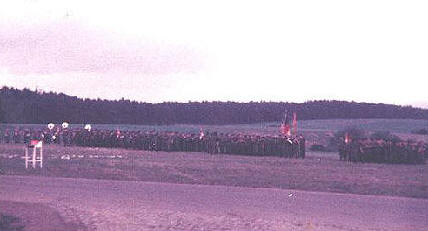
The Border Camp is to my rear, this is
the open field just across the road. The ceremony is the re -
dedication of the camp as the name is changed to honor Lt Lee.
--Mike McGehee |
|
| |
|
|
|
|
| |
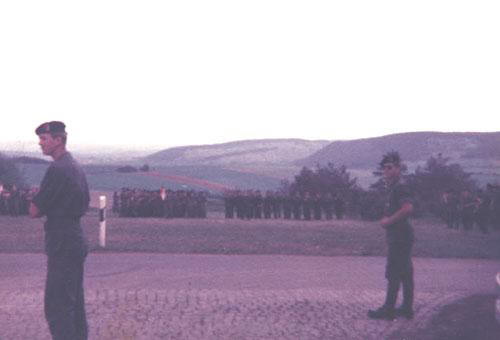
Another view of the assembled troops,
band from Fulda, German guests from the Bundeswehr and
Bundesgrenzschutz.
--Mike McGehee |
|
| |
|
|
|
|
Stefanowicz: Lt Lee was from Columbus,
Ohio but had come to consider Virginia his home. The city of
Columbus and state of Ohio honors it's participants in the Vietnam
war with a civic memorial but it contains no names. The Camp Lee
sign that spanned the entrance to the border camp until the site was
returned to German control lies on the roof of the former two bay
motor shop. It is faded but still legible. Lt Lee is remembered at
the National Vietnam Memorial in Washington on panel 03W / 080.
***************************
We gratefully thank the following troopers for
helping us tell this story: Lee Allen, Clint Anker, Jack Tartella,
Michael Craig and Wayne Watts. Pete Echon provided the photos from
various troopers showing both Lt Lee and Troop F in the field in
Vietnam. Other photos as credited.
|
|